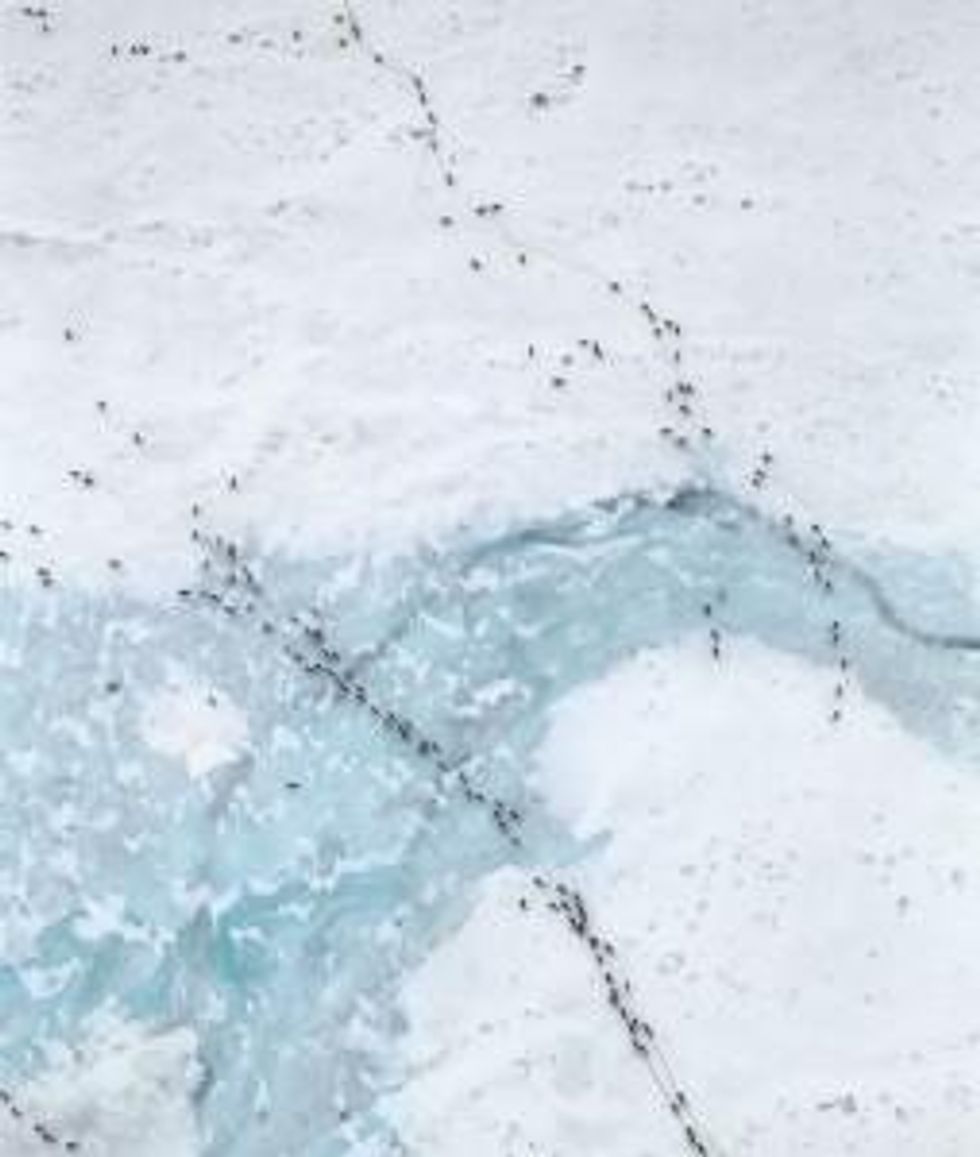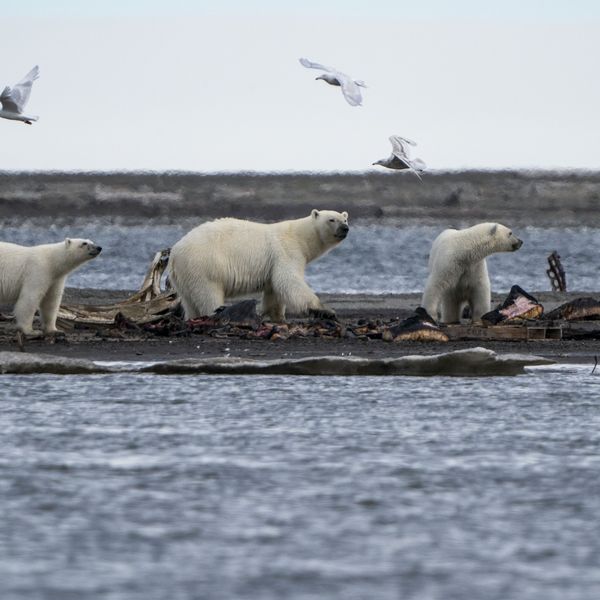Keep the Arctic Cold
I wrote a letter to the editor as a follow up to the generous review "In the Beautiful,Threatened North" by Ian Frazier in The New York Review of Books of the anthology, Arctic Voices: Resistance at the Tipping Point that I edited.
I wrote a letter to the editor as a follow up to the generous review "In the Beautiful,Threatened North" by Ian Frazier in The New York Review of Books of the anthology, Arctic Voices: Resistance at the Tipping Point that I edited. My letter, "Can Shell Be Stopped?" has just been published in the New York Review.

After the June 6 issue (with my letter) went to the printer a few significant things happened that relate to the letter that I'll mention here briefly.
On May 10, the White House published a 13-page document, "National Strategy for the Arctic Region." It opens with a one-page introduction by President Obama. He begins with these words: "We in the lower forty-eight and Hawaii join Alaska's residents in recognizing one simple truth that the Arctic is an amazing place." All fifty-five contributors in Arctic Voices, I'm sure, will be very pleased with these words from the President. But before the tears of joy could flow down my cheeks, the droplets dried up as I began to read the second paragraph: "Our pioneering spirit is naturally drawn to this region, for the economic opportunities it presents..." President Obama hides his excitement for oil and gas drilling in the Arctic Ocean by carefully choosing the euphemism--"economic opportunities." In page 7 the true intent of the report is finally revealed: "The region holds sizable proved and potential oil and natural gas resources that will likely continue to provide valuable supplies to meet U.S. energy needs." Of course the report mentions protecting the environment but gives no specific details.
This major report from the White House was released after we came to know that on midnight on May 7, the average global CO2 concentration had reached 400 parts per million (ppm). The pre-industrial average was 280 ppm. The Scientific American reported, "[T]he last time CO2 levels are thought to have been this high was more than 2.5 million years ago, an era known as the Pliocene." This is so significant that Scientific American now plans to publish in the coming year a "400 ppm" series of articles, "to examine what this invisible line in the sky means for the global climate, the planet and all the living things on it, including human civilization." And George Monbiot correctly pointed outin The Guardian, "The only way forward now is back: to retrace our steps and seek to return atmospheric concentrations to around 350 ppm, as the 350.org campaign demands."
We may have forgotten, or didn't pay attention, that the Arctic had reached 400 ppm almost exactly a year ago. A May 31, 2012 press release from the National Oceanic and Atmospheric Administration (NOAA) stated, "The concentration of carbon dioxide in the atmosphere of Barrow, Alaska, reached 400 parts per million (ppm) this spring, according to NOAA measurements, the first time a monthly average measurement for the greenhouse gas attained the 400 ppm mark in a remote location. ... Carbon dioxide at six other remote northern sites in NOAA's international cooperative air sampling network also reached 400 ppm at least once this spring: at a second site in Alaska and others in Canada, Iceland, Finland, Norway, and an island in the North Pacific."
Arctic is the barometer of our planet. When it comes to climate change, if you want to know what will happen tomorrow, do not hire an astrologer, instead simply pay attention to what's happening in the Arctic today. Dr. James Hansen and I are currently engaged in a conversation that will be published in the paperback edition of Arctic Voices in August. As Jim told me, "We must keep the Arctic cold, for us to have a stable planet."
Drilling in the Arctic Ocean is a wrong path for the planet. By asking "Can Shell Be Stopped?" in the NYR, I wasn't interested in philosophical contemplation but rather to figure out a practical path that might stop oil and gas drilling in the Arctic Ocean-a small but significant step toward helping to "keep the Arctic cold."
An Urgent Message From Our Co-Founder
Dear Common Dreams reader, The U.S. is on a fast track to authoritarianism like nothing I've ever seen. Meanwhile, corporate news outlets are utterly capitulating to Trump, twisting their coverage to avoid drawing his ire while lining up to stuff cash in his pockets. That's why I believe that Common Dreams is doing the best and most consequential reporting that we've ever done. Our small but mighty team is a progressive reporting powerhouse, covering the news every day that the corporate media never will. Our mission has always been simple: To inform. To inspire. And to ignite change for the common good. Now here's the key piece that I want all our readers to understand: None of this would be possible without your financial support. That's not just some fundraising cliche. It's the absolute and literal truth. We don't accept corporate advertising and never will. We don't have a paywall because we don't think people should be blocked from critical news based on their ability to pay. Everything we do is funded by the donations of readers like you. Will you donate now to help power the nonprofit, independent reporting of Common Dreams? Thank you for being a vital member of our community. Together, we can keep independent journalism alive when it’s needed most. - Craig Brown, Co-founder |
I wrote a letter to the editor as a follow up to the generous review "In the Beautiful,Threatened North" by Ian Frazier in The New York Review of Books of the anthology, Arctic Voices: Resistance at the Tipping Point that I edited. My letter, "Can Shell Be Stopped?" has just been published in the New York Review.

After the June 6 issue (with my letter) went to the printer a few significant things happened that relate to the letter that I'll mention here briefly.
On May 10, the White House published a 13-page document, "National Strategy for the Arctic Region." It opens with a one-page introduction by President Obama. He begins with these words: "We in the lower forty-eight and Hawaii join Alaska's residents in recognizing one simple truth that the Arctic is an amazing place." All fifty-five contributors in Arctic Voices, I'm sure, will be very pleased with these words from the President. But before the tears of joy could flow down my cheeks, the droplets dried up as I began to read the second paragraph: "Our pioneering spirit is naturally drawn to this region, for the economic opportunities it presents..." President Obama hides his excitement for oil and gas drilling in the Arctic Ocean by carefully choosing the euphemism--"economic opportunities." In page 7 the true intent of the report is finally revealed: "The region holds sizable proved and potential oil and natural gas resources that will likely continue to provide valuable supplies to meet U.S. energy needs." Of course the report mentions protecting the environment but gives no specific details.
This major report from the White House was released after we came to know that on midnight on May 7, the average global CO2 concentration had reached 400 parts per million (ppm). The pre-industrial average was 280 ppm. The Scientific American reported, "[T]he last time CO2 levels are thought to have been this high was more than 2.5 million years ago, an era known as the Pliocene." This is so significant that Scientific American now plans to publish in the coming year a "400 ppm" series of articles, "to examine what this invisible line in the sky means for the global climate, the planet and all the living things on it, including human civilization." And George Monbiot correctly pointed outin The Guardian, "The only way forward now is back: to retrace our steps and seek to return atmospheric concentrations to around 350 ppm, as the 350.org campaign demands."
We may have forgotten, or didn't pay attention, that the Arctic had reached 400 ppm almost exactly a year ago. A May 31, 2012 press release from the National Oceanic and Atmospheric Administration (NOAA) stated, "The concentration of carbon dioxide in the atmosphere of Barrow, Alaska, reached 400 parts per million (ppm) this spring, according to NOAA measurements, the first time a monthly average measurement for the greenhouse gas attained the 400 ppm mark in a remote location. ... Carbon dioxide at six other remote northern sites in NOAA's international cooperative air sampling network also reached 400 ppm at least once this spring: at a second site in Alaska and others in Canada, Iceland, Finland, Norway, and an island in the North Pacific."
Arctic is the barometer of our planet. When it comes to climate change, if you want to know what will happen tomorrow, do not hire an astrologer, instead simply pay attention to what's happening in the Arctic today. Dr. James Hansen and I are currently engaged in a conversation that will be published in the paperback edition of Arctic Voices in August. As Jim told me, "We must keep the Arctic cold, for us to have a stable planet."
Drilling in the Arctic Ocean is a wrong path for the planet. By asking "Can Shell Be Stopped?" in the NYR, I wasn't interested in philosophical contemplation but rather to figure out a practical path that might stop oil and gas drilling in the Arctic Ocean-a small but significant step toward helping to "keep the Arctic cold."
I wrote a letter to the editor as a follow up to the generous review "In the Beautiful,Threatened North" by Ian Frazier in The New York Review of Books of the anthology, Arctic Voices: Resistance at the Tipping Point that I edited. My letter, "Can Shell Be Stopped?" has just been published in the New York Review.

After the June 6 issue (with my letter) went to the printer a few significant things happened that relate to the letter that I'll mention here briefly.
On May 10, the White House published a 13-page document, "National Strategy for the Arctic Region." It opens with a one-page introduction by President Obama. He begins with these words: "We in the lower forty-eight and Hawaii join Alaska's residents in recognizing one simple truth that the Arctic is an amazing place." All fifty-five contributors in Arctic Voices, I'm sure, will be very pleased with these words from the President. But before the tears of joy could flow down my cheeks, the droplets dried up as I began to read the second paragraph: "Our pioneering spirit is naturally drawn to this region, for the economic opportunities it presents..." President Obama hides his excitement for oil and gas drilling in the Arctic Ocean by carefully choosing the euphemism--"economic opportunities." In page 7 the true intent of the report is finally revealed: "The region holds sizable proved and potential oil and natural gas resources that will likely continue to provide valuable supplies to meet U.S. energy needs." Of course the report mentions protecting the environment but gives no specific details.
This major report from the White House was released after we came to know that on midnight on May 7, the average global CO2 concentration had reached 400 parts per million (ppm). The pre-industrial average was 280 ppm. The Scientific American reported, "[T]he last time CO2 levels are thought to have been this high was more than 2.5 million years ago, an era known as the Pliocene." This is so significant that Scientific American now plans to publish in the coming year a "400 ppm" series of articles, "to examine what this invisible line in the sky means for the global climate, the planet and all the living things on it, including human civilization." And George Monbiot correctly pointed outin The Guardian, "The only way forward now is back: to retrace our steps and seek to return atmospheric concentrations to around 350 ppm, as the 350.org campaign demands."
We may have forgotten, or didn't pay attention, that the Arctic had reached 400 ppm almost exactly a year ago. A May 31, 2012 press release from the National Oceanic and Atmospheric Administration (NOAA) stated, "The concentration of carbon dioxide in the atmosphere of Barrow, Alaska, reached 400 parts per million (ppm) this spring, according to NOAA measurements, the first time a monthly average measurement for the greenhouse gas attained the 400 ppm mark in a remote location. ... Carbon dioxide at six other remote northern sites in NOAA's international cooperative air sampling network also reached 400 ppm at least once this spring: at a second site in Alaska and others in Canada, Iceland, Finland, Norway, and an island in the North Pacific."
Arctic is the barometer of our planet. When it comes to climate change, if you want to know what will happen tomorrow, do not hire an astrologer, instead simply pay attention to what's happening in the Arctic today. Dr. James Hansen and I are currently engaged in a conversation that will be published in the paperback edition of Arctic Voices in August. As Jim told me, "We must keep the Arctic cold, for us to have a stable planet."
Drilling in the Arctic Ocean is a wrong path for the planet. By asking "Can Shell Be Stopped?" in the NYR, I wasn't interested in philosophical contemplation but rather to figure out a practical path that might stop oil and gas drilling in the Arctic Ocean-a small but significant step toward helping to "keep the Arctic cold."

